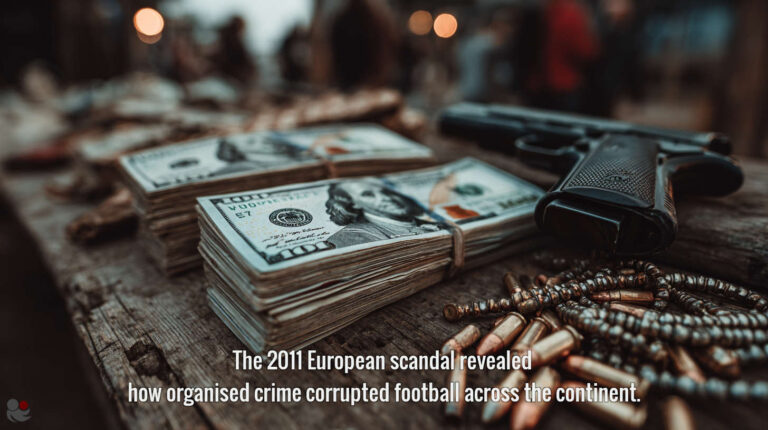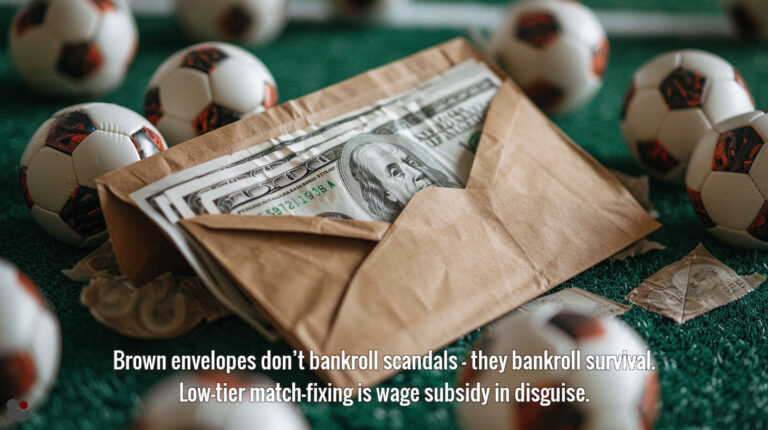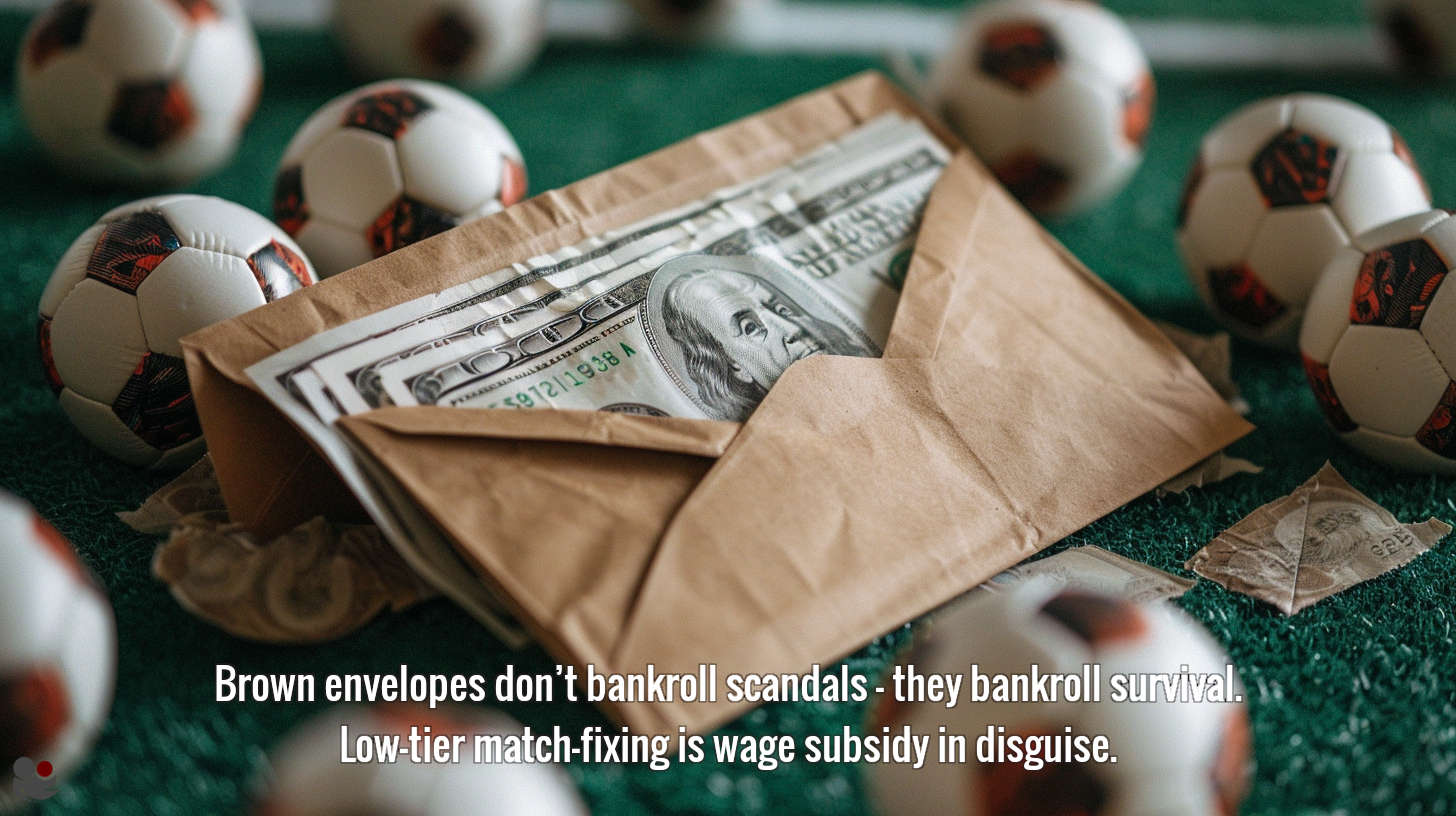
When the payslip runs dry, the brown envelope suddenly looks like the team's sponsor.
Ten cases, one truth: Fixes aren’t scandals, they’re systematic – the rule, not the exception.
A player and his friend pleaded guilty to a scheme in which the pair bet on the player receiving yellow cards, with courts and regulators only alerted when a licensed bookmaker raised the alarm.
In August 2025, Western United’s financial collapse – late wages, unpaid tax bills, licence revoked – showed the perfect breeding ground for corruption. Where wages are shaky, match fixing finds its moment.
The Pattern Hiding in Plain Sight
Why Goals Still Count When Everything Else Is Rigged
Sources
Sportradar doesn’t whisper about this – they count it. In 2023 alone, the firm flagged 1,329 suspicious matches across 70 sports, about 0.21% of all events – roughly one in every 467 matches. In 2024, the number fell to 1,108, bringing the ratio to about one in every 615 matches.
This isn’t new. It never was. The history of football (and many other sports) is littered with examples where thin pay packets and fragile systems made manipulation inevitable. Match fixes recur, they are far from random, and realistically only a fraction are ever detectable – the rest vanish into the dark number.
Here are ten cases – spanning continents and decades – that show low-tier match-fixing is less a scandal and more a parallel economy..
Ten Cases-Proof: Low-Tier Match-Fixing Is a Shadow Wage System ⤴️
-
“A Sainsbury’s Bag of Cash” – England’s Conference, 2010s
Moses Swaibu, once a defender in England’s lower leagues, told reporters how a fixer handed him a six‑figure cash bundle in a plastic shopping bag (as reported by The Sun) to help sway a match.
At his level, that was equivalent to years of wages in one go. The method was brazenly simple: cash for influence, no sophistication required.
Players struggling with rent and family bills saw fixing not as a moral dilemma but as a financial lifeline.
Takeaway: In lower leagues, one bag of cash can outweigh an entire career’s wages.For context: Estimates put a Premier League player around £60,000 per week on average, while League Two sits near £2,000 per week (industry aggregates; not official disclosures). One short-term fix in Conference football can equal a season’s pay. That’s why a six‑figure bundle isn’t just temptation – it maybe perceived as the real wage.
-
“Malta’s €1,000 Men” – Semi-Pro Survival, 2015
In Malta, semi‑professional footballers often earned low four‑figure monthly wages – and, crucially, wages were frequently delayed.
Reports revealed that syndicates used this to their advantage, approaching players with far larger sums to shape matches. Fixers not only bribed individuals but sometimes financed clubs themselves, effectively embedding corruption into the league’s economy.
For many teams, shady money was the difference between paying wages or folding mid‑season; players routinely faced wage arrears of several months. (Malta Today)
Takeaway: When clubs can’t afford payroll, match fixers become the paymasters. -
“Referees on Pennies” – Eastern Europe, 2012
Academic studies highlighted how referees in certain Eastern European second divisions earned less than the cost of their travel expenses. With wages so pitiful, the referees themselves became the weak link.
A small bribe could guarantee a penalty, a disallowed goal, or a convenient red card.
The return on investment for match fixers was enormous compared to the cost of buying influence at the very top levels. (Appalachian State Economics PDF)
Takeaway: Underpaid referees are the cheapest lever to pull in football. -
“Calciopoli’s Quiet Lessons” – Italy, 2006
Calciopoli is remembered for Juventus boardrooms and powerful executives, but underneath the headlines lay a culture of favours and survival mechanisms.
Clubs desperate to stay in Serie A, referees seeking career advancement, and small-time club officials willing to ‘arrange’ outcomes – these were the drivers.
The scandal was less about masterminds in smoky rooms and more about a system where everyone was compromised a little. (Italian press archives)
Takeaway: Even at elite levels, desperation, not glamour, drives the fix. -
“K-League Collapse” – South Korea, 2011
The K-League scandal led to dozens of bans for players and referees. Investigations revealed that organised crime simply tapped into vulnerabilities already present within the league.
Players were supplementing meagre salaries with arranged outcomes. Match-fixing became semi-normalised inside club culture, not imposed from outside.
It was endemic, not extraordinary. (Springer Journal)
Takeaway: When low wages normalise match fixes, crime just joins the queue. -
“Nicaragua’s $5,000 Deals” – All Sports, 2021
Reports from Nicaragua uncovered how match-fixing was not confined to football but stretched across volleyball and baseball.
The going rate? Between $500 and $5,000 per fix, depending on the stakes.
For athletes whose monthly income was often below $200, these offers were irresistible. Corruption was not a side hustle – it was the survival strategy that kept sports afloat. (Divergentes)
Takeaway: When $5,000 equals several months’ pay, integrity is a luxury. -
“Sportradar Knows, But Can’t Pay Wages” – Global Data, 2020s
Fraud-detection firms like Sportradar flag suspicious betting patterns weekly, often in obscure leagues from the Balkans to Central Asia.
Yet, while algorithms can highlight statistical anomalies, they cannot solve the root cause: players and referees not being paid enough.
Fixing is not an anomaly but a predictable outcome of economic desperation. The tech detects smoke, but the fire still burns unchecked. (Wired)
Takeaway: Technology can flag fixes – but it cannot feed unpaid players. -
“Belgium’s Integrity Time Bomb” – Academic Findings, 2024
Research in Belgium revealed a direct connection between late or unpaid wages and match-fixing incidents.
Clubs that missed payroll dates were effectively placing their players on the open market for fixers. Delay salaries by a month, and suddenly a midfielder with rent due was ready to listen to an offer.
Bureaucratic inefficiency turned into corruption risk overnight. (Ghent University Repository)
Takeaway: Late wages aren’t admin errors – they’re invitations to match fixers. -
“From Survival to Strategy” – Historical England & Italy
Historically, match-fixing was often a tool of survival rather than greed.
In Italy and England, clubs facing relegation or financial ruin would view manipulation as insurance rather than scandal. The players weren’t chasing yachts; they were chasing security.
This pattern recurs whenever football economics falter – fixing slips from being a criminal conspiracy to an accepted, if unspoken, strategy. (Historical sports archives)
Takeaway: Match fixing is often less about crime – and more about survival maths. -
“The Offshore Curtain” – Crypto Betting Era, Now
Even as licensed bookmakers proudly showcase their integrity monitoring, the real battleground lies offshore. Crypto‑based sportsbooks take bets regulators can’t see, and fixers know it.
UK reporting has shown mainstream payment rails reaching unlicensed sites, while the Financial Times estimates crypto casinos’ 2024 GGR at roughly $81bn – ample oxygen for micro‑fixes.
A yellow card in a minor league, a misplaced goal kick, or a deliberately skewed corner – these micro-events are enough to generate returns when funneled through unregulated platforms.
Fixing doesn’t need to be grand. It needs only to be invisible. (Current betting reports)
Takeaway: In the crypto era, the smallest act can bankroll the biggest scam.
Gubbing shows bookmakers tilt the market.
Either way, it isn’t the punter who comes out ahead.
Here’s our explainer on gubbing.
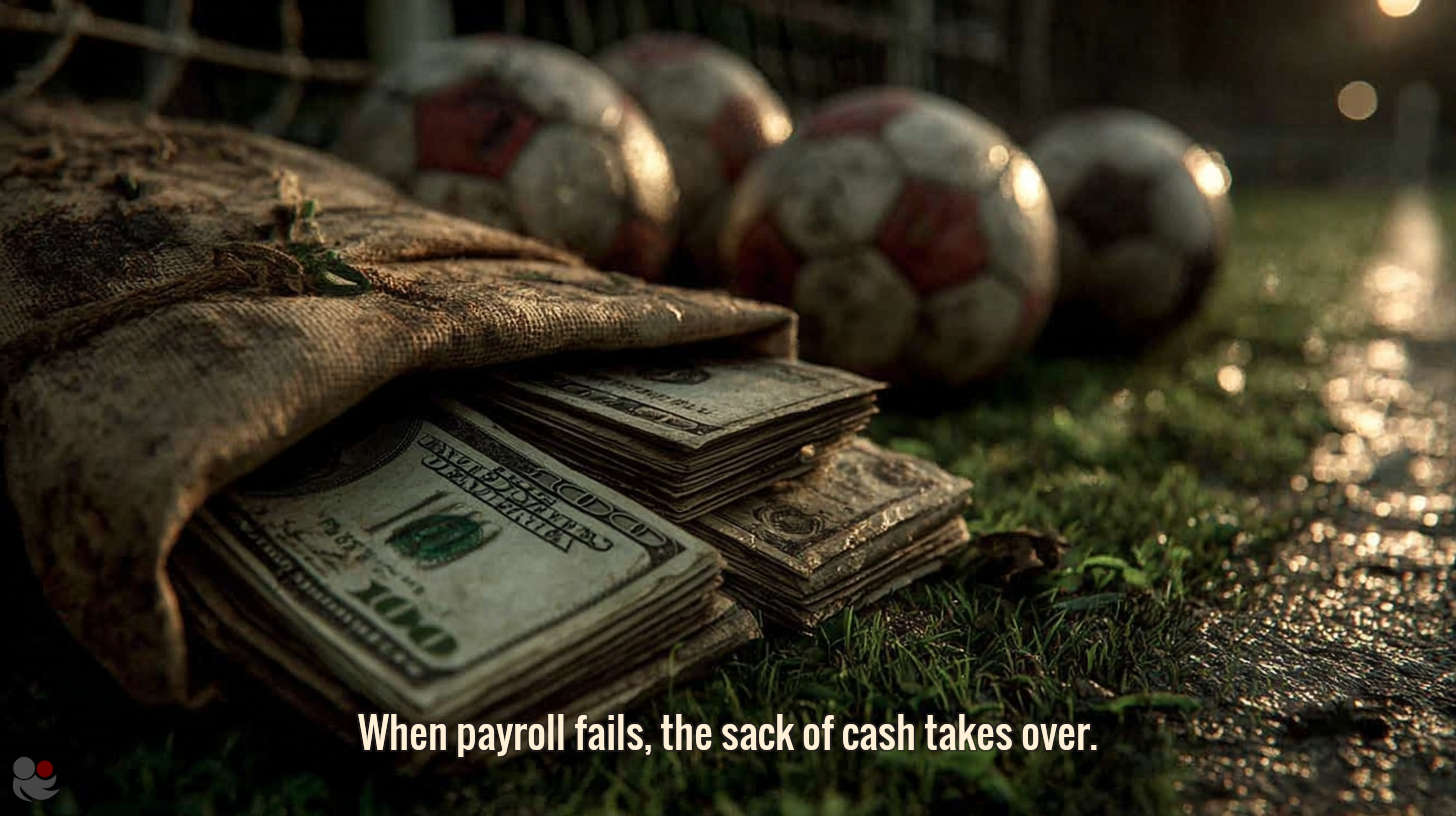
HDAFU Tables run profit-loss simulations on the bright lights of the big leagues.
You won’t spot a fixer here – but whether your betting logic survives the market.
Explore the HDAFU Tables.
Free betting tips sell dreams you shouldn’t trust.
In both cases, the price is hidden – and it’s usually your bankroll.
Why free advice isn’t always free.
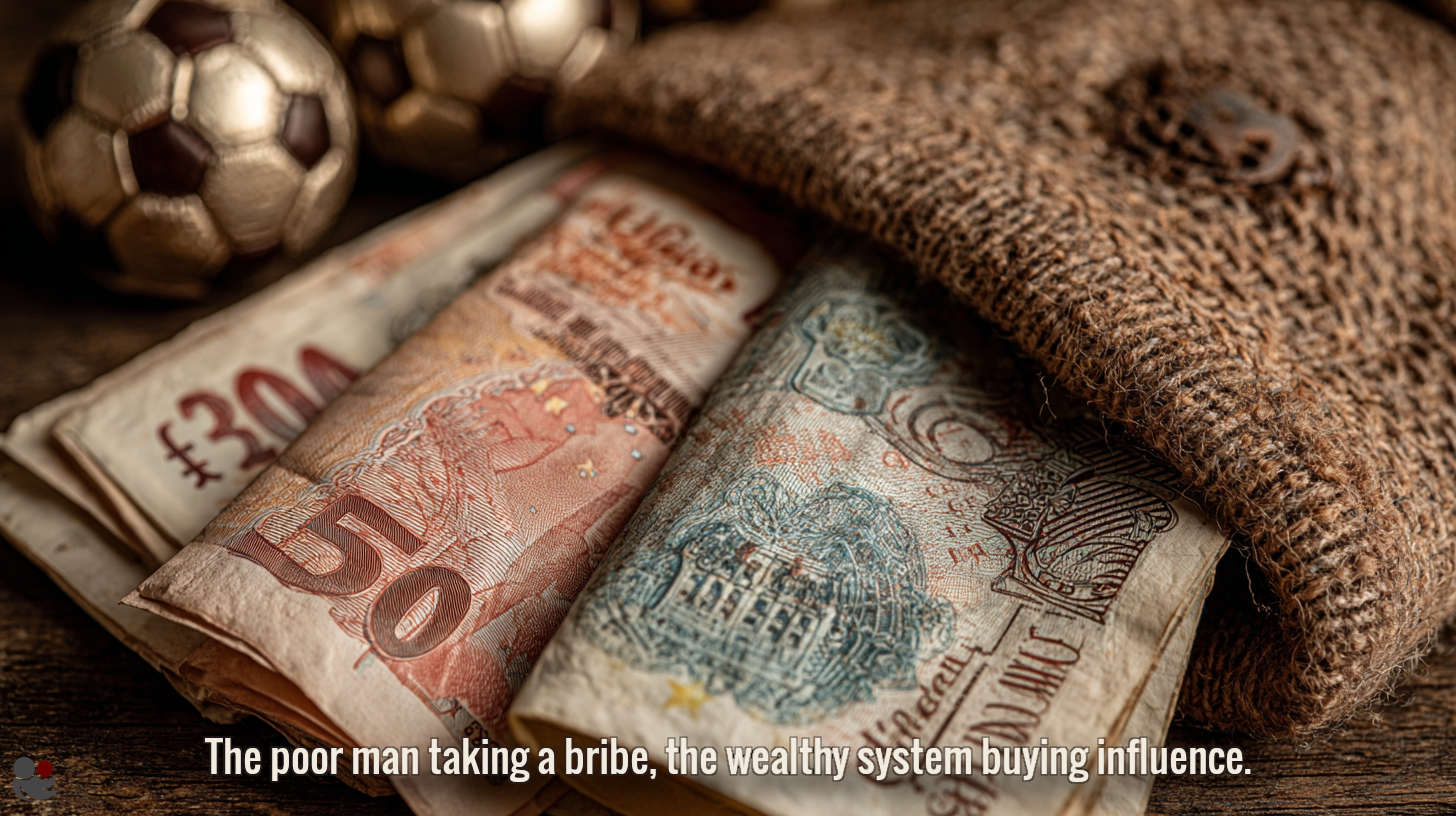
in-play punters need to grasp how conditional probabilities really work.
Otherwise, you’re just another wallet feeding the offshore circus.
In-Play Value & Conditional Probabilities.
The Pattern Hiding in Plain Sight ⤴️
Look across these examples and the rhythm is obvious: thin wages, shaky governance, offshore opportunity. Match fixing does not flourish in spite of football’s structures – it flourishes because of them. Each “rare” case officials parade as exceptional is simply another iteration of the same economic logic.
And punters? They pretend to be horrified, but they keep betting. Some even dream of spotting the fix and profiting from it. It’s the same delusion every gold-digger has: that they’ll be the one to strike it lucky, not just the one supplying the shovel.
The real odds are clear. Fixers will keep fixing. Bettors will keep betting. And football authorities will keep issuing the same shocked statements – until the next brown envelope arrives.
Call it corruption if you like. However, in practice, the truth is that in low-tier football, match-fixing isn’t a scandal. It’s a survival strategy.
So, next time you hear an official insisting “match fixing is rare,” translate it: “luckily, we haven’t had to admit the latest known yet.” Punters will still bet, clubs will still collapse under strain, and the brown envelopes will still arrive.
It’s the only time the bookies actually get beaten,
as match-fixers make them pay.
Although the fixers supply the envelope,
it’s the bookmakers who bankroll low-tier football.
Why Goals Still Count When Everything Else Is Rigged ⤴️
Sportradar’s data shows the fixers rarely touch the scoreboard.
In 2023 they flagged 1,329 suspicious matches, and in 2024 another 1,108. However, the bulk of those weren’t bent wins or losses. They were the micro-events that cost little to buy and are almost impossible to trace.
Fixer pay for incidents that are cheap to arrange, easy to hide, and barely affect the final outcome: a yellow card, a mistimed corner, a throw-in given the wrong way.
These leave the result looking intact while the betting market gets milked.
To reiterate:
- If you’re chasing cards, corners, or “team with most fouls,” you’re playing on the fixer’s turf.
- If you stick to what you can actually model – goals, scores and outcomes – the probability game is yours to play.
- Goals decide the outcome of 1X2 and Over/Under markets.
- Everything else – cards, corners, possession, “momentum” – might influence the match narrative but not the bettor’s edge.
- Even if those things may appear predictive, they’re exactly where fixers meddle – which makes them unreliable for punters.
Master Sharp Betting. Dominate Over Under & Value Betting.
Explore Soccerwidow’s Over/Under Course:
The Science of Football Predictions: Over Under ‘X’ Goal
Sources Consulted ⤴️
- The Guardian – A-League scandal (Aug 2025)
- The Sun – Moses Swaibu and the Sainsbury’s bag (six‑figure cash bundle, England Conference)
- Malta Today – Match-fixing pays underpaid players and finances clubs
- Appalachian State Economics – Study on referee corruption incentives
- Italian press archives – Calciopoli lessons
- Springer Journal – K-League fixing culture (2011)
- Divergentes – Nicaragua’s $5,000 deals across multiple sports
- Wired – Sportradar fraud detection analysis
- Historical sports archives – England & Italy match fixing
- Ghent University – Research on late wages and fixing risk
- University of Cumbria – Matchfixing: a historical perspective
(Copy and paste into Google if you really want the full articles. We prefer you stay here, of course.)
This article names no names and makes no accusations. It highlights structural patterns in football economics, not individual guilt. All cases cited are already public record; what’s new is the analysis.
Have your own story? Drop examples of match-fixing you’ve seen or heard about in the comments – the more daylight we throw on these cases, the clearer everything becomes.

